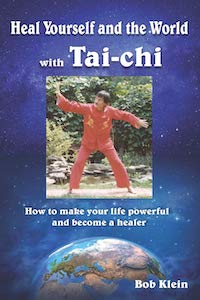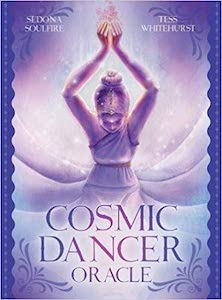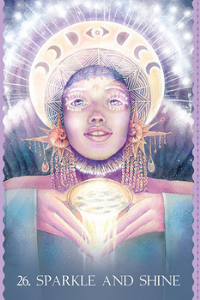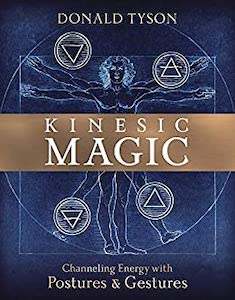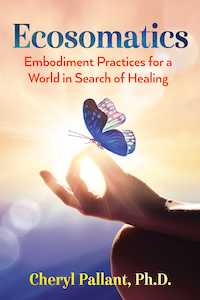
Ecosomatics: Embodiment Practices for a World in Search of Healing, by Cheryl Pallant, Ph.D.
Bear & Company, 1591434769, 224 pages, June 2023
A few weeks ago, I had an energetic anatomy healing with psychic healer Madison Lang. For over an hour, she scanned the energy of my physical body from miles away; Madison is located in Minnesota, while I’m in New Jersey. At times, she told me of symbolic images residing in certain parts of my body, such as a clock, representing influence from my maternal grandmother creating soreness in my arm. Other times, she focused her keen awareness on misaligned, extra, and stagnant energy in my body, clearing away blockages and rebalancing my physical body energetically.
The whole experience was phenomenal. And afterwards, I felt like a million bucks! Physical symptoms that had been lingering for months disappeared. My consciousness felt situated within my body again, rather than floating outside myself. My confidence improved, as I was more connected to myself from within rather than making judgements about myself from external standards or perceptions. Madison’s encouragement to release attachment to my pre-pregnancy body and attune myself to my current body– wider hips, a softer belly, and big nursing chest–help me to embrace where I am in life right now with gratitude.
It felt a bit synchronistic to begin reading Ecosomatics: Embodiment Practices for a World in Search of Healing, by Cheryl Pallant, Ph.D. shortly after my energetic anatomy healing, as though the Universe was encouraging me to continue to learn more about the connection between myself and my body. Dr. Pallant’s concept of ecosomatics, or “embodiment work for personal and planetary health”1, goes one step beyond the psychic healing experience I had and grounds it into the physical realm. It has been a wonderful resource on my journey of expanding my perception to be more attune to my body and cultivating my own somatic intelligence.
“For those who are attentive, my touching you provides information about you and the touch also provides you with information about me. The place of contact opens the gate to all sorts of information, especially for healers whose highly sensitive hands rest gently on the skin surface and in the subtle field of the body to detect heat, cool, tingles, pressure, and more. . . Every part of the body leads to a specific awareness, emotion, sensation, imagery, and/or memory, perceptible to those who notice.”2
In Ecosomatics, Pallant asserts that shifting consciousness through expanding one’s sensory perceptions and attuning to the natural rhythms of one’s body has the power to transform on both a personal and collective level. While modern social problems, inadequate healthcare systems, and ecological crisis are pushing humanity towards the brink of destruction, Pallant believes somatic awareness can be a source of healing that aids in the evolution of human consciousness.
As context for her point of view, Pallant goes right to the core of how bias and perception can influence belief systems. She acknowledges the safety of collective belief systems, but encourages readers to delve into discomfort and have the courage to expand their perception to be more inclusive of the intuitive and energetic aspects of ourselves not readily seen with our eyes. This integrative approach helps to release fears, anxieties, and limiting beliefs and opens a doorway for the evolution of consciousness through somatic intelligence.
Drawing upon her own career experience, which includes a Ph.D. in Somatic Writing, certification in Reiki and Healing Touch, and training in Process-Oriented Psychology, Authentic Movement, and yoga, Pallant provides first hand experience of her own journey of discovering the healing ability within herself. She also provides plenty of client anecdotes that aid readers in believing that this somatic shift in perception is achievable.
But her approach to this topic is not a subjective one; Ecosomatics is filled with explanations from fields such as psychology, sociology, quantum physics, and neurobiology. Pallant also expertly weaves together her personal experiences with insight from experts in other related modalities focused on integrating mind, body, and self, such as Healing Touch, 5Rhythms, and Body-Mind Centering, to give readers a wide-range of approaches to somatic healing.
“Common knowing privileges logic, reasoning, and head-centered knowing. Missing is a comprehensive sense of the body that includes intuition, embodiment, energetic, and spiritual awareness that is integrative rather than fractional. Missing is a place and appreciation for uncanny experiences and impressions that don’t readily fit into our belief system.”3
A key theme of Pallant focuses on is interconnection. My favorite chapter, “The Ecology of Self” discusses topics such as energetic resonance, how people’s energy and emotions can be projected onto others, the impact of both fear and love in our lives, and the concept of “we space”. She writes, “Nascent in our development are intrapersonal practices that contribute to coming to know what lives in our shared personal spaces.”4
I really enjoyed contemplating the idea of sharing energetic spaces and observing this energy exchange throughout the week in different places I went. At first, I noticed how much my energy felt scattered and seemed to change based on the vibe of where I was and the energy of those around me; I was losing connection to myself and trying to camouflage into the energy around me.
But by actually doing the “Try This” exercises Pallant offers throughout Ecosomatics, I began to ground back into my own body and become more aware of the somatic experience I was having instead of leaving/ignoring the sensations of my body. I’m still working on my embodiment, but through these exercises, I am coming to understand what Pallant means when she writes:
“By stepping embodied into the fullness of who we are, what takes place is a transformation and a coherence of personal well-being that extends to all sentient and insentient beings and marks us as responsibly partaking in the ecology of self and the planet. What takes place is alignment with the present moment, which reaches out infinitely.”5
The final chapter, “Embodiment Practices”, is one that I’ll definitely be returning to time and time again. Pallant provides different practices for the reader to do in order to cultivate their sense of embodiment. These range from transforming fear and worry into love to balancing masculine and feminine energy to aligning with one’s flow through creative expression.
The one practice I’ve done so far was intended to help develop my intuition, using what I’ve learned about embodiment to discern between fantasy and my intuition. As someone who is clairsentient, it is helpful to be able to feel embody when connecting to my intuition and learning where emotions reside within my body.
All in all, Ecosomatics is a wonderful resource for those interested in expanding their perceptions to be more inclusive of their physical experience. Pallant puts forth a compelling thesis for why embodiment is vital to the growth of our consciousness and does a great job teaching readers how it can be done. The healing potential is infinite. This read is sure to shift how readers perceive themselves in the world around them, awakening them to the experience of embodiment and as a result more acutely attuning to the surrounding energy.
Alanna Kali is an astrologer, numerologist, and pioneer spirit that loves to explore life through the lens of depth psychology. She has a passion for studying the humanities and social trends. Her academic work is centered upon reuniting body, mind, and spirit through eco-psychology. She loves reading, spending time in nature, and travel.


